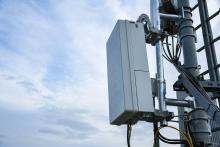How It Works
Bluetooth connections are based on piconets. A piconet includes a master device and up to seven slave devices. An additional 254 devices can be in a parked state waiting to join the piconet. The user's device initiating the communications is the master. It controls the clock for synchronization and the frequency-hopping sequence. Bluetooth uses spread-spectrum radio in the 2.4-GHz band (as do 802.11b and 802.11g) based on frequency hopping.
Distinguishing and isolating one piconet (my notebook-to-cell phone connection, for example) from another (say, your cell phone-to-headset connection) is the frequency-hopping sequence. The master polls the slaves for information, and manages resources by assigning communications time slots in a time-division structure. Connection speeds can be as high as 721 Kbps in one direction and 57.6 Kbps the other way in an asymmetrical configuration, or 432.6 Kbps in each direction in a symmetrical configuration. A piconet also can support three full-duplex voice channels at 64 Kbps. These speeds are fine for modem connections, voice communications, synchronizing PDAs, and retrieving low- and medium-resolution digital images, but not fast enough for peripherals, such as digital video cameras.
Another challenge with Bluetooth is that two devices can communicate with each other only if they support the same Bluetooth profile. A profile is a set of capabilities that use the Bluetooth protocol layers (see diagram, "Key Bluetooth Protocols," page 86), and provide a well-defined service--SPP (serial port profile), dial-up networking, headset, hands-free, LAN access, fax profile, file transfer and synchronization. So if your cell phone supports only the hands-free profile and your headset supports only the headset profile, the two devices won't work together with Bluetooth.
The SPP profile emulates an RS-232 serial-port connection, including control wires, so that any application that uses a serial cable can use Bluetooth instead. The latest version of the Bluetooth spec is 1.2, which was completed last November. It supports adaptive frequency hopping to alleviate interference and offers faster connection times, better voice quality and extended support for scatternets (when a device participates in two piconets). The new version is also backward-compatible with version 1.1.








